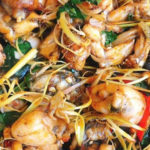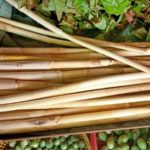Wild vegetables, or rau rừng, are a delicacy for those who venture into the forests and cultivate the land in Vietnam. These wild greens are known for their unique flavors and are commonly paired with dishes such as bánh xèo (Vietnamese savory pancakes) and bánh khọt (mini savory pancakes), creating a truly mouthwatering experience. As a result, rau rừng has gained popularity, and connoisseurs of fine cuisine seek it out as a way to enhance their dining pleasure when paired with these distinctive vegetables. Not only are these greens renowned for their aromatic flavors and delicious taste, but they also boast a high nutritional value.
1 Star Gooseberry Leaves
Who hasn’t heard of cóc, the tangy fruit that is so refreshing? Well, lá cóc (star gooseberry leaves) are the leaves of this very plant! This vegetable is easy to find, as it grows wild all over Vietnam. However, the leaves from the Tây Ninh region are considered the most delectable.
Star gooseberry leaves are green and have a distinctive fragrant, nutty flavor, packed with Vitamin C, making them a healthy addition to any meal. In addition to enhancing the flavor of dishes, these leaves are known to aid in weight loss, cool the body, reduce blood fat, and stimulate digestion.
When cooking with star gooseberry leaves, people usually pluck the young, tender leaves and stems. The crunchy stems and sour leaves add a delightful tang to dishes, especially when used in sour soups (canh chua).
Star gooseberry leaves can be paired with various meats, but they seem to go best with seafood, especially fish such as cá lạc, cá cờ, cá lóc, and cá dò.
 Star Gooseberry Leaves
Star Gooseberry Leaves
2 Frog Legs
Frog legs, or đùi ếch, are a delicacy in many parts of the world, including Vietnam. They are often prepared in a variety of ways, from being deep-fried to grilled, and are known for their tender, juicy meat and unique flavor.
In Vietnam, frog legs are particularly popular in the Mekong Delta region, where they are considered a specialty. They are typically cooked in a variety of ways, including being stir-fried with garlic and chili, grilled over charcoal, or simmered in a sweet and sour sauce.
While frog legs are a delicious treat, they are also believed to have medicinal properties. In traditional Vietnamese medicine, they are thought to help improve blood circulation, boost energy levels, and even enhance sexual performance.
 Frog Legs
Frog Legs
3 Wild Betel Leaves
Wild betel leaves, or lá trầu rừng, are a type of leaf that is commonly used in Southeast Asian cuisine, particularly in Vietnam. These leaves have a strong, distinctive aroma and are often used to wrap meats and other ingredients before grilling or steaming.
In Vietnamese cuisine, wild betel leaves are often used in dishes such as bò lá lốt (grilled beef wrapped in wild betel leaves) and chả lá lốt (steamed pork and shrimp paste wrapped in wild betel leaves). The leaves add a unique flavor and aroma to the dishes, making them a favorite among locals and tourists alike.
In addition to their culinary uses, wild betel leaves are also believed to have medicinal properties. In traditional Vietnamese medicine, they are thought to aid in digestion, relieve stomachaches, and improve oral health.
 Wild Betel Leaves
Wild Betel Leaves
4 Mangosteen Leaves
While the mangosteen fruit is widely loved for its sweet, tangy flavor, the leaves of the mangosteen tree are also used in Vietnamese cuisine. Known as lá măng cụt, these leaves are used as a wrapping for grilled dishes, adding a unique flavor and aroma to the food.
In Vietnam, grilled dishes are often wrapped in mangosteen leaves before being placed on the grill. This practice is believed to infuse the food with the leaves’ essential oils, resulting in a more flavorful dish. Mangosteen leaves are also used to wrap foods such as bánh xèo (Vietnamese savory pancakes) and nem chua (fermented pork rolls), adding a distinct aroma and flavor to these popular snacks.
In addition to their culinary uses, mangosteen leaves are also believed to have medicinal properties. In traditional Vietnamese medicine, they are thought to aid in digestion, relieve stomachaches, and boost the immune system.
 Mangosteen Leaves
Mangosteen Leaves
5 Sour Plum Leaves
Sour plum leaves, or lá me, are another type of leaf used in Vietnamese cuisine. These leaves have a sour and slightly astringent taste, making them a perfect pairing with dishes that need a tangy kick.
In Vietnam, sour plum leaves are often used in dishes such as canh chua me (sour plum soup) and cá kho tộ me (clay pot fish stew with sour plum). The leaves add a distinctive sourness to the dishes, balancing out the flavors and creating a unique taste profile.
In addition to their culinary uses, sour plum leaves are also believed to have medicinal properties. In traditional Vietnamese medicine, they are thought to aid in digestion, relieve stomachaches, and improve blood circulation.
 Sour Plum Leaves
Sour Plum Leaves
6 Banaba Leaves
Banaba leaves, or lá duối, are the leaves of the duối tree, which is native to Southeast Asia. These leaves are known for their medicinal properties and are used in traditional Vietnamese medicine to treat a variety of ailments.
In terms of culinary uses, banaba leaves are often used as a wrapping for grilled dishes, similar to mangosteen leaves. They impart a slightly bitter taste to the food, which is believed to have health benefits. Additionally, banaba leaves are used to make a herbal tea that is thought to help regulate blood sugar levels and promote weight loss.
 Banaba Leaves
Banaba Leaves
These wild vegetables were once considered a delicacy by food connoisseurs due to their wild nature. However, they are now cultivated and distributed widely, making them more accessible to home cooks. You can find these unique vegetables in traditional markets or even in supermarkets across Vietnam.
Wild Forest Vegetable, Sought-After Delicacy.
The elusive wild vegetable, sought-after by many and elevated to a delicacy status, is an intriguing topic to explore. This mysterious forest produce has captured the interest of food enthusiasts and curious explorers alike, sparking a culinary adventure into the wild. As we delve into the world of this exotic vegetable, we uncover the secrets behind its allure and its transformation into a revered specialty.



































